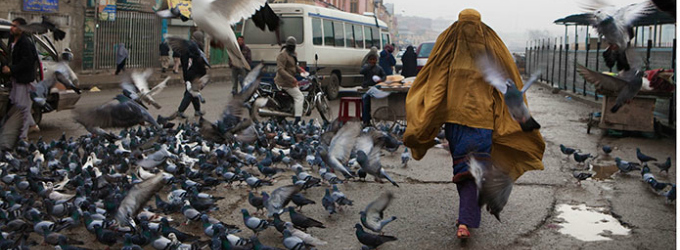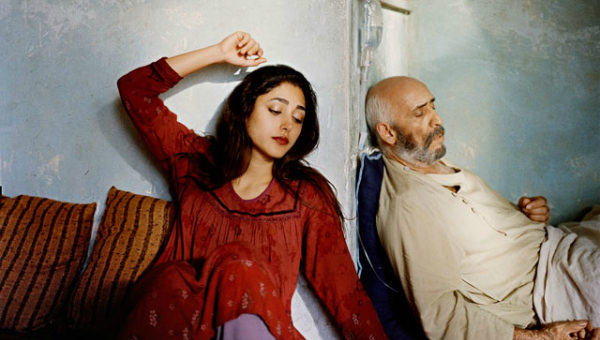 THE PATIENCE STONE is a slow-paced, close-up examination of a married couple living in a warzone that could be Afghanistan. The location, like the names of the couple are left undefined. The film stars Golshifteh Farahani (ABOUT ELLY) as the young wife of a much older man, who is a soldier. He is in a persistent vegetative state, having been shot; the bullet is lodged in his neck and the wound won’t heal. She nurses him to the best of her ability but there is no medical aid, just occasional visits from the imam who assures her that he will recover if only she prays enough. There are few necessities, let alone comforts, in this war-damaged town.
THE PATIENCE STONE is a slow-paced, close-up examination of a married couple living in a warzone that could be Afghanistan. The location, like the names of the couple are left undefined. The film stars Golshifteh Farahani (ABOUT ELLY) as the young wife of a much older man, who is a soldier. He is in a persistent vegetative state, having been shot; the bullet is lodged in his neck and the wound won’t heal. She nurses him to the best of her ability but there is no medical aid, just occasional visits from the imam who assures her that he will recover if only she prays enough. There are few necessities, let alone comforts, in this war-damaged town.
She has tolerated much to be a ‘good’ wife, but underneath she’s in turmoil.
The town is frequently shelled, and lawlessness rules: it’s a precarious, claustrophobic existence with little chance of escape. Throughout the film there are few sounds, apart from the patient’s steady breath, until incoming mortars explode. The deafening noise shocks the audience every bit as much it shocks as the characters on screen. In the quiet between rocket attacks, the regular rhythm of the patient’s breath dictates the pace: she quietly mops his head, concocts a saline drip when she can’t buy the real thing from the pharmacist, tacks plastic sheeting to blasted windows, sweeps glass and dust after a rocket attack.
The woman has endured a loveless, abusive marriage. She has tolerated much to be a ‘good’ wife, but underneath she’s in turmoil. She has bottled up her thoughts, emotions and ambitions throughout her marriage, but now the husband lays comatose and dependent, she begins to reveal those inner landscapes to him. He has become her ‘patience stone’. A patience stone acts as a confessional – you tell the stone your troubles, it absorbs all your sadness until it can take no more and it shatters, taking your troubles with it. As the days pass she becomes bolder, delving deep into her thoughts and emotions and eventually revealing the truth of her daughters’ heritage. But what happens to them both when the ‘stone’ cracks?

While the man seems to have treated her abysmally, once he is injured and powerless, and most importantly speechless, their roles change: she controls him. He must listen to whatever she speaks about – if he can hear her at all. He is no longer the soldier-husband, away for years at a time: in becoming the patience stone, he must absorb all her grief. At last he does something for her benefit, albeit unknowingly. That he is a patient in the medical sense and has patience forced upon him by his injury, adds resonance to the title.
THE PATIENCE STONE is a thoughtful film that raises issues around speaking and listening, especially to the female voice, women’s status, responsibilities, intimacies and loyalties. While the women are voluble, the men either can’t speak at all (the husband) or have speech difficulties (the young soldier with whom she strikes up a relationship has a debilitating stammer). It’s perhaps an overly simple device to mark out the ‘differences’ between men and women and it takes a little getting used to.
… a beautifully constructed film, intimate, enlightening …
THE PATIENCE STONE features some high quality acting from both leads. Farahani’s performance is totally believable in conveying the young woman’s developing story, but Hamid Djavadan also deserves attention. His portrayal of the comatose husband/the stone is remarkable; he does indeed seem to be in a coma, and remains unblinking despite the intrusive closeness of the camera lens.
How will it all end? Will she find some kind of freedom, safe from militia gangs and incoming rockets, safe from her husband’s unwanted urges? You have to see the film to find out what happens to this brave, resourceful and intelligent woman. THE PATIENCE STONE is undoubtedly a beautifully constructed film, intimate, enlightening, and with an appropriately ambiguous final scene that allows the viewers space to draw their own conclusions.
httpvh://youtu.be/lQHRV57sugs


Thanks, Amanda – it was a good recommendation !